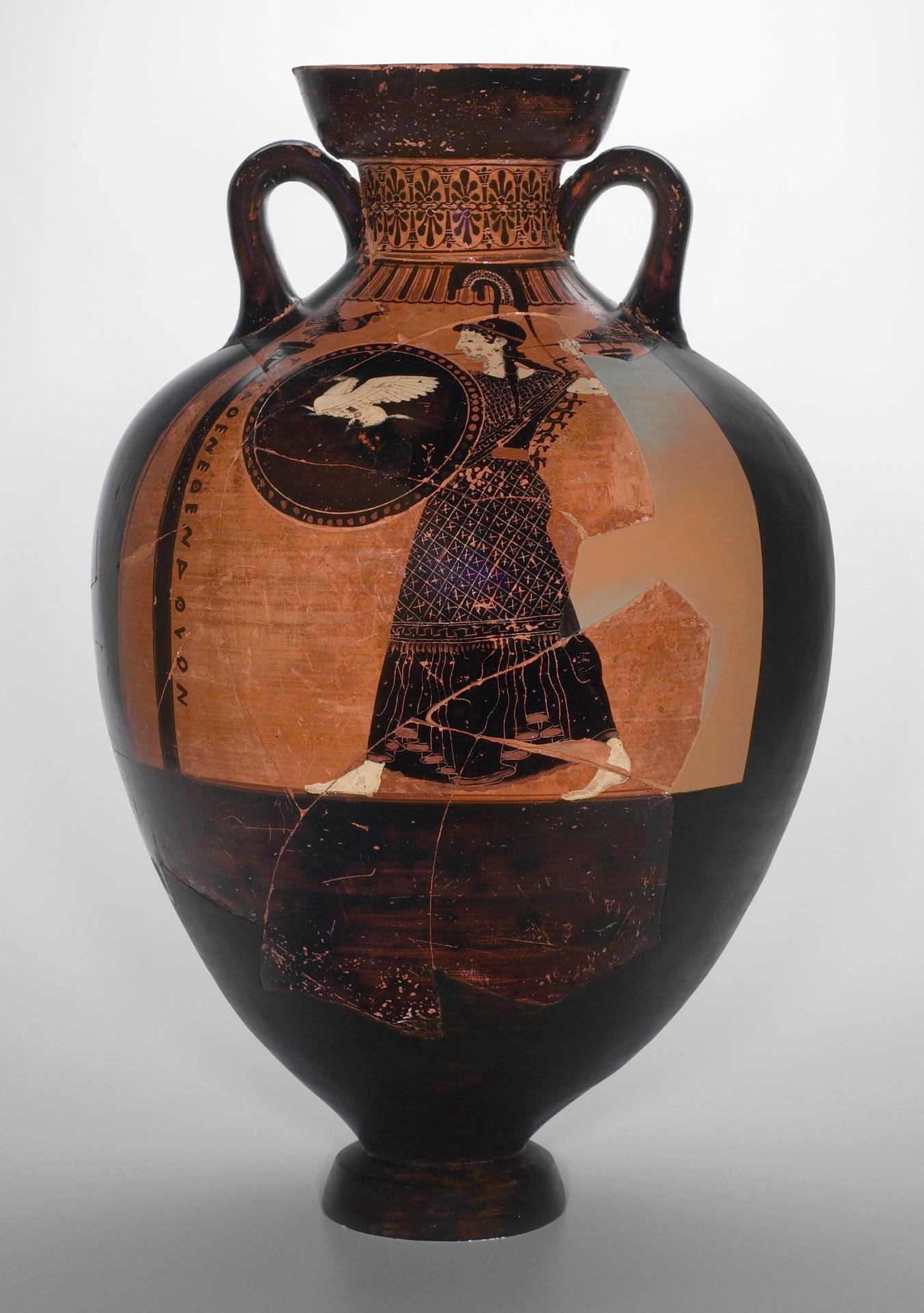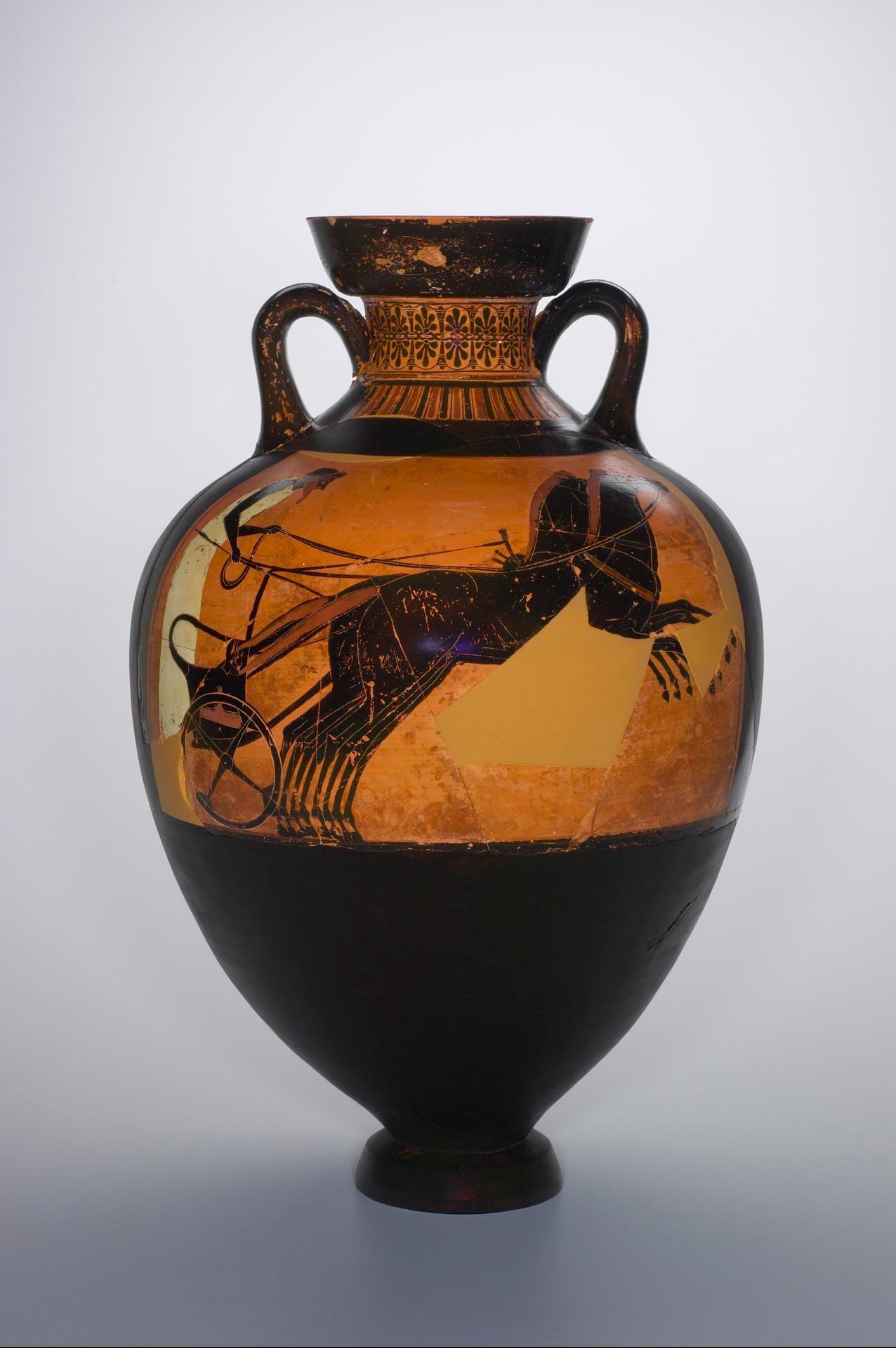Although the Ancient Greek amphora may be able to hold over half a ton of liquid it may also reveal much of the culture, religion, and art of ancient Athens. An analysis of the Panathenaic Prize Amphora attributed to the Kleophrades Painter (ca. 490 BCE) shows devotion to Athena, the patron goddess of Athens, and civic pride through athletic contests and artistic expression, making this particular vessel not only a practical object but also a symbolic one.

As one approaches the vessel, the first thing that is registered is the Black Figure painting technique, characteristic of Greek ceramics, featuring bright red terracotta contrasted with black slip and inscribed decorations. This requires extreme levels of craftsmanship and technical knowledge.
The two sides of the amphora depict different, yet possibly related, scenes. The first portrays a large figure with white skin and a black, decorated, tunic, allowing us to interpret it as a woman. She is wearing a skirt decorated with geometric patterns such as the meander, as well as a necklace and earrings, which point to her femininity. Her face is oval-shaped, with almond-shaped eyes, a straight nose, and a small mouth, her hair arranged in curls, all showing her beauty. Looking closer, we see that she also wears a helmet and a breastplate, and holds a spear in her left hand and a shield in her right hand, all indicating her power even as she is rendered mid-step. Through this armor and attributes, the figure can be identified as Athena, the Greek goddess of “wisdom, weaving, and defensive and strategic warfare.” She is depicted in between Doric columns, which may be representative of the Parthenon, her temple on the Acropolis. The shape of the amphora has an interesting effect on the image: the artist uses the curves of the vessel to visually distort the parallel columns while also creating a vertical axis that aligns with Athena’s body, further elongating her to make her seem larger than life and emphasizing her importance. This balance of depictions is powerful as it illustrates the simultaneous respect and love the Athenians had for the goddess.
Additionally, the vessel shows a deep mastery of the artistic and architectural principles of the Kleophrades Painter. The columns are rendered in a perspective manner, creating a sense of depth and movement as they taper at the top and are fluted on the sides to play with light and shadow. The capitals are topped with roosters that touch the vessel’s neck decoration, making it almost seem like a temple pediment. Also, to the side of the image, there is a Greek inscription that translates to “From the Games at Athens,” indicating the context of its creation. The painting itself is also interesting; it is a square that has been imposed, having a clear-cut edge that suddenly stops the illustration from taking what seems to be its natural course to the base of the vessel. It seems almost odd, but may speak to the placement of the amphora in the time it was used: if it were to be placed below eye level, then the bottom of the amphora would not be seen and thus does not need to be painted.
The Panathenaic Games featured athletic and musical competitions, such as the four-horse chariot race illustrated on the other side of the amphora. Considered to be a dangerous competition that required great skill, the horses are depicted in motion, with their legs and tails extended, while the charioteer is shown in profile, leaning forward while holding reins and whips in his hands. We know that the figure is male due to his black skin and red beard, which is also indicative of his advanced age. The charioteer is wearing a long white tunic which exposes his muscular arms and contrasts the rest of the illustration. The chariot race is rendered with a sense of action, complemented by the amphora’s shape as its curved surface follows the movement of the horses and chariots, making it seem as if they were about to leap off of the vessel.
Considering the vessel in its original context, the scenes portrayed are reminiscent of other images seen in Greek antiquity. As the image of Athena represents her role as the patron deity of Athens and the protector of the city, it is a widely recognizable motif and most likely reused after the design became diffused over the ages. It can be seen in the frieze of the Parthenon itself, other amphorae and paintings seen in class, as well as sculptures, such as the restored Minerva standing in Rudolph Hall at the Yale School of Architecture. Interestingly, the figure featured on the shield Athena is holding is not one of Medusa, as is commonly shown, but of a pegasus. This may be used as a way to highlight the differences between the mortals and gods, as the former has trained horses on earth while the latter has tamed greater beasts. Nevertheless, both have gained control over other species, which further elevates the importance of the games celebrated with the vessel. The image of a four-horse chariot race is also similar to the depictions found on other Greek vases, such as the Late Geometric Krater (760-735 BCE) at the Metropolitan Museum of Art. Being a display of military might, the motif was widely used to illustrate the strength of Athens, and points to the possible use of the amphora as a trophy for the winner of the chariot race, whose success rewarded him with fame and a beautiful (as well as expensive) amphora.
The imagery found on the Panathenaic Prize Amphora relates to its potential use as a celebration of the achievements of the athletes who competed in the Panathenaic Games, as well as honoring the goddess Athena and her city.
Bibliography
Gaifman, Milette, “Becoming Oriental,” Yale University, Lecture III (PPT slide 15)
Gaifman, Milette, “Body Politics in the Age of the Tyrants,” Yale University, Lecture VI, September 20, 2023
Gaifman, Milette, “List of Greek Olympian Gods and Primary Attributes,” Yale University
Liu, Ziming, “Greek Painted Pots: Artwork or Artifact?,” Yale University, Lecture VII, September 25, 2023
“Panathenaic Prize Amphora: A: Athena, B: Four-Horse Chariot,” https://artgallery.yale.edu/collections/objects/643





